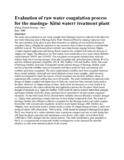| dc.description.abstract | The study was conducted on raw water samples from Masinga reservoir collected at the inlet into raw water balancing tank at Masinga-Kitui Water Treatment Plant by running typical jar tests. The main problem at the plant is poor floes formation on addition of conventional dosage of coagulant; hence, obliging the operators to use excessive dose of alum to achieve a considerable turbidity removal. The treatment plant currently uses alum dosage ranging between 80ppm-112ppm standard application and during floods respectively, coupled with Soda ash dosages of 16ppm and 32ppm.
The laboratory Jar Test studies were conducted on raw water whose turbidity varied between 79NTU and 310 NTU. The coagulants investigated included alum with and without Soda ash at varying dosages, alum plus coagulant aids, polyaluminium chloride (P ACL) and four different polymers (Algaefloc 195, K 300, Sudfloc 3284 and Sudfloc 3820). The seeds of Moringa Oleifera were also investigated and the optimal dosage of Moringa Oleifera seeds and the achievable turbidity removal compared with those achieved with conventional and synthetic polymeric coagulants.
The main experimental variables used were coagulant chemical doses, initial turbidity, initial pH and initial alkalinity of raw water samples, while the main criteria investigated to check the success of each coagulant was the final turbidity values of supernatant after constant settling time set at 60 minutes. The study established an optimum alum dosage of 40ppm coupled with 4ppm dose of Soda ash; much less than currently being used at the plant. However, at 28ppm dosage of alum, Soda ash is not necessary as it was found to be counterproductive; this option offered the best application practice for the plant.
Much lesser dosages of polymers (e.g. 2ppm for Sudfloc 3820) could be used to achieve better floes strength and higher turbidity removals; hence, polymers have a potential to be more potent coagulant chemicals. On the other hand, PACL showed better turbidity removal efficiency at leaner dosages i.e. 12ppm while generating compact and easy to treat sludge compared to alum.
The seeds of Moringa Oleifera also offered an effective coagulant for the Masinga waters and could compete favourably with conventional coagulants; however much higher dosages ofM. Oleifera (i.e. 100ppm) were involved to achieve similar results as alum. At 28ppm dosage of alum, a daily cost saving of about 330% (from Kshs. 7840 to Kshs. 2380) would be realised at Masinga-Kitui plant. PACL was found to be a viable substitute since it produces compact and easy to treat sludge that will keep the plant's operation and maintenance costs down; with a daily cost of about Kshs. 3,000 that is 260% cheaper than the current practice. The study established a great potential in PACL as a coagulant and recommends further investigations on the chemical for possible adoption in other water treatment plants in the country. | en_US |

